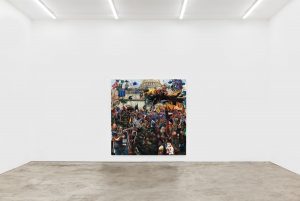Click the link below to get closer to Celeste Dupuy-Spencer’s epic painting of the January 6th insurrection at the Capitol, Don’t You See That I Am Burning.

https://www.miergallery.com/exhibitions/celeste-dupuy-spencer3/videos
What follows is a commentary on the painting available through the Nino Mier Gallery where Don’t You See That I Am Burning was on exhibit in Los Angeles from March 3-24.
On January 6th 2021 thousands of people stormed the U.S. Capitol in a coordinated attempt to overturn the defeat of the 45th President of the United States as a result of the 2020 presidential election. During a joint session of the 117th United States Congress to formalize the Electoral College Vote Count and confirm the 46th President, a throng of rioters occupied and vandalized the Capitol Building, breached police parameters to maim and ultimately kill police officers, and erected gallows to hang the incumbent Vice-President. Five people died and more than 140 people were injured.
Los Angeles-based artist Celeste Dupuy-Spencer’s painting, Don’t You See That I Am Burning, memorializes in paint the throngs of people that are caught in the act of this violent protest. Members of the anti-government paramilitary Oathkeepers can be seen next to ardent Trump supporters, while neo-fascist Proud Boy Groups are amassed together with Q-Anon enthusiasts, Evangelical and Christian prayer groups, white supremacists of all ages, as well as ordinary Americans both men and women alike. The palpable energy of the painting is aided not only by the sheer number of bodies that are present but by the rippling flags that bear slogans such as “Soldiers in God’s Army”, “Jesus is King”, “Trump’s Law and Order”, “Hang Judas” and “Father Don’t You See I’m Burning”. Dupuy-Spencer is able to conjure chaos not only throughout the crowds, but also through an alternate reality occupying the upper right quadrant of the painting where out of a smokey haze struts a stout Walrus and the Carpenter from Lewis Carroll’s Alice in Wonderland who overlook a sea of proverbial oysters dressed in red MAGA and green camouflage.
The gendarmes represented within the painting are driven as much by the truth of the actual events as our own mythologies surrounding them. For what makes this painting impactful is not the detailed representation of a historical assault on the nation’s capital, but the folklore surrounding the division of the nation’s political cultures, and it’s influence on the monstrous events of the day. The painting reflects the urge to utilize the right-wing masses and far-right rioters as a lens through which to see ourselves. By contrasting ourselves against “them” we set ourselves as diametrically opposed. In times of shock and inevitable horror, we become innocent and good. Celeste’s frenzied brushstrokes and painstaking detail encourage us to confront our own myths, not just about those who would wave those flags and storm the capital, because the rioters leave little room for embellishment, but about ourselves as among those who looked on in horror.
By painting the events of January 6th as a monumental historical painting, Celeste engages the viewer as a part of the story being told. Thus, while the painted figures are indeed monstrous, the viewer must take stock in their own perception – what does their perception of “them” say about their perception of themselves? If we are to bear witness to the fall of the American empire, will we be brave enough to recognize ourselves as the supporting actors who take part in the finale of its demise? Will the riots serve to wake us up from the fantasy of the American dream, or will they chase us further into the comfort of our imagined decency and goodness, thus into the anesthetic sleep?
The withering, fragile American dream has failed and a Freudian interpretation rooted in Die Traumdeuteung is able to dismount the symbolism which belies a factual and accurate historic description of the day.